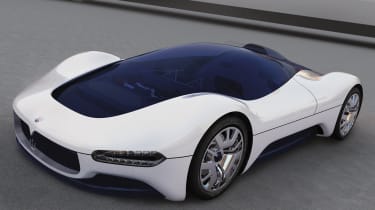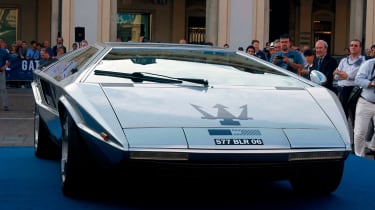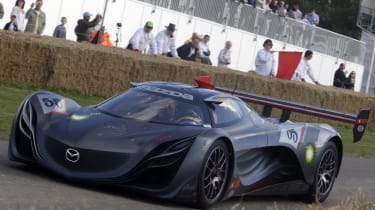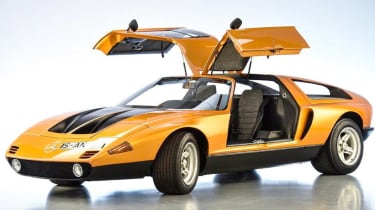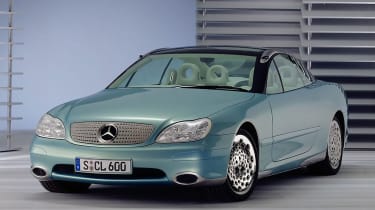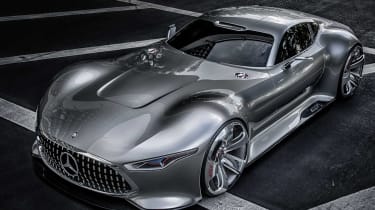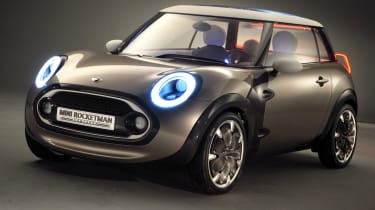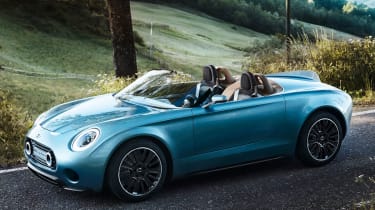Concept cars: the all-time greatest designs
Concept cars are what happens when the car industry lets its imagination run wild. We pick out the greatest ever concepts...
Maserati Birdcage 75th (2005)
Debuting at the 2005 Geneva Motor Show, the Maserati Birdcage was built to both celebrate the 75th anniversary of Pininfarina and to pay homage to the lightweight Maserati racing cars of the 1950’s.
Built predominantly from carbon fibre and based on the carbon fibre chassis and 700bhp V12 from the Maserati MC12 GT1, the Birdcage still ended up weighing 1,500kg.
The exterior design was created around two fundamental aerodynamic forms; a teardrop, which envelopes the passenger cell and mechanicals, and an inverted wing in which the central section is suspended. The LED headlights were the first of their kind to be homologated and their casings are made from solid blocks of aluminium.
The entire Perspex canopy section rises skyward, giving the car its most dramatic design element while also providing access to the cockpit. Once inside, there was a transparent dashboard that was supported by a triangulated tubular structure in a nod to the original 50s race cars. The Birdcage featured some futuristic technology inside including a heads-up display and a Motorola communications unit housed in the steering wheel, while a special headset worn by the driver could feed information on the driving experience to a chosen audience. Unfortunately, this was only ever destined to be a concept car and is now housed in the Pininfarina collection.
Maserati Boomerang (1972)
Following its success with the Maserati Bora, Italian styling house Italdesign built the Boomerang concept for the 1972 Turin Auto Show. Penned by the legendary Giorgetto Giugiaro, it arrived at the show as a fully-functioning prototype, fitted with the same aluminium 4.7-litre, quad-cam V8 from the Maserati Bora.
The Boomerang has around 300bhp and 460Nm. Power is sent through a five-speed manual gearbox to the rear wheels, and the top speed stands at a theoretical 170mph. Which isn’t bad for 1972.
According to Giugiaro, the Boomerang was designed “almost exclusively with a ruler.” The doors featured similar glass panelling to the 1967 Lamborghini Marzal Concept, while the windscreen was raked at only 13 degrees.
However, the Boomerang’s most interesting design feature is its unorthodox dash. All the dials and switchgear are housed on a panel within the dish of the steering wheel, which was originally designed to house an airbag.
Mazda Furai (2008)
The Furai was revealed at the 2008 North American International Auto Show in Detroit. Named after a Japanese phrase meaning ‘the sound of the wind’, it was designed as the final model to use Mazda’s “Nagare” design language.
The Furai took its inspiration from the world of motorsport. It was built on a modified version of the French-made Courage Compétition C65 Le Mans Prototype chassis and was powered by a 450bhp three-rotor wankel engine, inspired by Mazda’s Le Mans-winning 787B race car.
The engine ran on E100 Ethanol, and was mated to a six-speed sequential transmission, which sent its power to the rear wheels. The Furai was no trailer queen, either; it was regularly taken to the track and thrashed by Mazda’s test drivers.
To pay further homage to Mazda’s motorsport history, the Furai wore the Mazda 787B’s race number; 55.
Tragically, during a shoot at Bentwaters Park in 2008, the Furai’s engine bay caught fire and the concept was destroyed before the fire crew could extinguish it. Mazda were unable to rebuild the Furai, and the whereabouts of its remnants remain unknown.
Mercedes C-111 (1969)
Some concept cars are little more than an exercise in shocking motor show goers into dropping their champagne flutes but the Mercedes C111s were a whole series of concept cars that were as much about technology as they were eye-catching design.
From 1969, the basic C-111 platform served as the foundation for Mercedes to showcase innovations including multi-link rear suspension, gull-wing doors, Wankel rotary engines, advanced diesel technology and futuristic interior concepts. Third in the model line, the C-111-III used a 230bhp diesel engine and super-slippery aerodynamics to set and break nine speed records while the C-111-II used a 350bhp Wankel motor to deliver a 4.9s time for the 0-62mph sprint. In 1979, the last version of the car, C-111-IV, used a 500bhp 4.8-litre V8 to break the world closed circuit speed record with a 251mph effort.
The original C-111, with its 280bhp three-rotor Wankel engine and gull-wing doors, appeared at the Frankfurt Motor Show in 1969 to huge critical acclaim. The Bruno Sacco designed fibreglass body is enough of a treat even without the technology beneath and the knowledge of what the car would go on to achieve.
Mercedes F200 (1996)
Big Mercedes-Benz has frequently used concepts to showcase tech that will feature on production cars of the future. The grand F200 previewed the styling of the W220 S-Class and the C215 CL-Class, but many of its systems would hold much greater influence, with some only just making it into mass production over 20 years later.
The suspension, for example, introduced Mercedes’ Active Body Control system, compensating for body roll through corners. An electrochromic sunroof, which could be switched from transparent to opaque at the touch of a button, later appeared on the Maybach 62, while Bi-Xenon headlights and window airbags both appeared on later Mercs and many other cars.
It still continues to influence cars today, too: the F 200 featured video cameras in place of rear view mirrors - an idea that made it to production for the first time on the Audi e-tron.
It’s most unique feature still hasn’t made production, however: there was no traditional steering wheel, instead a joystick in the centre console which controlled steering and speed in-effect allowed the F 200 to be driven from either of the front seats.
Mercedes-AMG Vision GT (2013)
The Mercedes Vision GT was designed initially as a virtual concept car for exclusive use in the Gran Turismo 6 racing game. However, Mercedes’ design team was so proud of its digital handiwork, that it also brought the car to life with a real 1:1 scale model.
It was built around an all-aluminum space frame, clad in carbon fibre and borrowed a handful of components from Mercedes’s AMG parts bin. As a result, the Vision’s performance figures were considerable; with an AMG-sourced 577bhp 5.5-litre twin-turbo V8 propelling a car weighing only 1,385kg, it easily had enough grunt to outpace the SLS supercar of the day.
The Vision drew its inspiration from Mercedes’s historic models, with a gaping grille similar to that of the 300SL racer from the fifties as well as the company’s trademark gull-wing doors. Its interior was inspired by the 2013 Mercedes F1 programme, with the an F1-style steering wheel and gauges mounted in a floating glass console at the driver’s eye-line.
MINI Rocketman (2011)
When the MINI was first re-introduced under BMW ownership back in 2003, it had gained some noticeable weight over its predecessor. With each generation since, the MINI has gained inches in every direction and spawned bigger variations such as the Countryman and Clubman. People began to wonder how big a MINI would have to get before it would not be fit to hold the MINI name. Step forward the Rocketman.
Launched at the 2011 Geneva Motor Show, the Rocketman was designed to show that a modern MINI could indeed be ‘mini’. It measured just over three metres in length, which meant it was just 400mm longer than the 1959 original. The Rocketman was not just a design study as serious effort went into making this concept as production viable as possible.
The Rocketman used a carbon-fibre space-frame chassis and featured several unique design touches such as a large glass floating roof, stirrup-shaped rearlights and double-hinged doors for easier access to the cabin. MINI had hoped to put the Rocketman into production but this idea fell through. As of yet the brand has not completely shelved the idea of a mini MINI.
MINI Superleggera Vision (2014)
While Minis have always been quirky, first and foremost they are designed to be stylish yet affordable, mainstream transportation for the masses. Every now and then though, the designers like to take a break from scaling up hatchbacks, and in 2014 they blew us away with this, the MINI Superleggera Vision.
Inspired by classic racers of the 1950s and 60s, the two-seater roadster was handcrafted by Milan-based coachbuilders Touring Superleggera, injecting some Italian flair into the quintessentially British design.
No standard MINI parts were used on the concept, yet it remains unmistakably on-brand. The iconic bonnet stripes are embossed into the metal, and the spotlights are replaced by LED rings blended into the grille.
Working down the side of the car to the rear, things get decidedly more exotic with a pronounced ‘Touring’ coachline flowing from the front wheel to the tapered rear end. There we find some now-familiar Union Jack rear lights and an aero fin, reminiscent of that on a classic Jaguar D-Type. Inside, the retro roadster gets a minimalist interior while the electric powertrain provides the go to match the show.
Unveiled at the Concorso d’Eleganza Villa d’Este on the shores of Lake Como, the little MINI held its own against some of the finest, most expensive cars in the world. Like so many of the cars on this list, the Superleggera Vision sadly never made it into production, but it did remind us that the plucky MINI can still be more than just a family hatchback.
Click the links below to jump to different sections of the list or click on to page 7 here...

